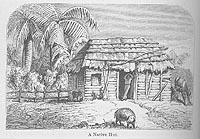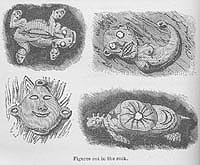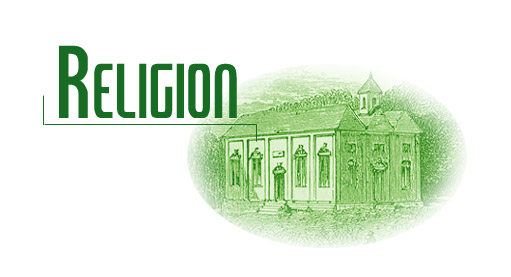
When
the willing agents of slavery dispersed the people of Africa, not only were people relocated,
but along with them parts of their culture, including their religions.
For the majority of Africans who ended up on the shores of St. Domingue,
voodoo (also sometimes spelled vo-du) was
their religion. Although one term is used to describe voodoo, there
are actually many different forms of voodoo, much as Christianity consists
of many different denominations. In voodooism,
however, peoples from different parts of Africa brought different religious beliefs, which combined and reshaped each
other in Haiti.
Still, some observers claimed that different strands of African
religion remained unentangled in their Haitian
descendants. For example, “the
Nago populations generally inhabit the north [of Haiti]…the Ibos tend to live in the southwest.”
[1]
The various voodoo sects differ as to which
god or gods are more important to that particular tribe.
Voodooism
involves the worship of a huge range of gods and goddesses, each with
separate powers. Worship takes place with “deities who manifested themselves
by possessing the bodies of their devotees.”
[2]
These deities are called loas,
which means spirit, as practitioners of voodoo believe that the spirit
of the gods possesses them when they pray. The worship of voodoo revolves
around the Oum’phor, or temple. It consists
or a large area, covered or uncovered, called a peristyle, in the middle of which
is a center post called a Poteau-mitan. Adjoining the peristyle on one side is a square house that is the oum’phor proper, or holy of holies.
[3]
It is in the Oum’phor
that rituals are performed, dances take place, and  initiation
rites are completed. Colonel
Venault de Charmilly
describes these little societies in his Lettre a M. Bryan Edwards…en refutation de son ouvrage, intitule Vues historiques sur la colonie francaise de Saint-Domingue
when he writes, “8000 & quelques petits societes, ou villages…des sauvages”
[4]
Or “8000 and some small societies, or villages
of the savages.” These small societies that Charmilly,
describes are different voodoo societies (as there was no centralized
system of voodoo, each village tended to have its own houn’gan or mam’bo,
or emperor/empress of the Oum’phor.)
initiation
rites are completed. Colonel
Venault de Charmilly
describes these little societies in his Lettre a M. Bryan Edwards…en refutation de son ouvrage, intitule Vues historiques sur la colonie francaise de Saint-Domingue
when he writes, “8000 & quelques petits societes, ou villages…des sauvages”
[4]
Or “8000 and some small societies, or villages
of the savages.” These small societies that Charmilly,
describes are different voodoo societies (as there was no centralized
system of voodoo, each village tended to have its own houn’gan or mam’bo,
or emperor/empress of the Oum’phor.)
Within
each village on the island of Haiti, certain responsibilities are bestowed
upon the houn’gan or mam’bo. These include the role of the medicine man, someone to whom one
can go to receive instruction regarding a particular problem, and that
of community elder; someone to whom the people look to represent their
village. The role of medicine man requires knowledge of various herbs
and ointments, as well as dances and rituals to please the gods. Pleasing
the gods is important because in voodoo, the relationship between the
natural world and the supernatural has its own cause and effect system
to explain otherwise unexplainable or unpredictable events. Not only
does voodoo provide guidelines for social behavior, but it also demands
that the gods be responsive.
[5]
Therefore, the status and position of the houn’gan depends not only on his or her knowledge of voodoo rites, but also
on his or her ability to manipulate and appease the public. Consequently,
the status of a houn’gan can alter if he is unable to explain or
predicts various events. Likewise, if the population has complete faith
in the powers of their houn’gan,
he can achieve a great following. The most well known anecdotes regarding
this involves the Haitian Boukman, who sparked
the revolution with a ritual sacrifice and has since gained almost mythic
qualities in Haitian culture.
The
connection between voodoo and everyday life is complex. Not only does
voodoo serve to unite and bring together the community in a spiritual
sense, but the meetings also allow the village residents to bring up
and solve any problems they might be facing, even if it has nothing
to with voodoo. For example, when it came time to do field work on their
farms, workers would often use the opportunity of the voodoo meetings
to organize work parties that rotated which plot of land was being worked.
Therefore, everybody’s land gets farmed with the least amount of work
and with the most expedience. The practice of voodoo not only brings
together laborers, but also families. As Courlander
writes in Religion and Politics
in Haiti, “The force of Vodoun has been
significant at the family level, strengthening family ties and keeping
alive a system of organization that has made life tolerable within a
larger society that has neglected the individual and his needs.”
[6]
Although there was no single “voodoo” religion in
Africa, the various African religions upon
which voodoo draws, such as the Yoruba and Dahomey, contain elements that can be identified
with voodooism today. The fact that voodoo
has helped to bring together and keep together families is important
because it has allowed the religion itself to start forming during the
Atlantic Passage, seemingly endless years of slavery, and society’s
own destructive influences. The role of voodoo in the family, therefore,
is one of unification and close ties.
Voodooism
played an important role during emancipation. Besides the fact that
the revolution was sparked by a voodoo ceremony, voodoo enabled the
people to meet together, form political and cultural ideals, and served
as the staging arena for pro-independence speakers to get their message
across. During times of slavery, voodoo was officially banned, but that
did not prevent the practice of voodoo in secret. This subversion and
active defiance of authority set the groundwork for larger resistance.
Voodoo was later legalized when a constitution was drawn up, but voodoo’s
influence on the revolution can be seen by the fact that prominent voodoo
officials sparked the revolution, while lesser leaders later brought
the message of freedom throughout the island.
 Not
only was voodoo an important part of family life, but it has also played
a very important role in politics, both at the village level and at
the state level. Because the Houn’gan
resides in such a respected role in the village, this person would inevitably
have political powers. At the village level, the Houn’gan was often the person who,
along with discussion between the workers, would decide when the time
was right to either plant or reap the harvest. He was also the person
to whom people went when they wanted things they did not understand
explained. This level of trust meant that the Houn’gan of a particular village, if he acted wisely and garnered
the good favor of his fellow villagers, could attain a position of much
power, at least on a small, local scale. Regarding political matters
on a nation wide scale, we have already seen what the influence of one
Houn’gan, Boukman, can have on the Island’s political spectrum. With the words,
“Throw away the symbol of the god of the whites who has so often caused
us to weep,” as C.L.R. James recounts, Boukman
launched the revolution that would forever change the face of St. Domingue.
[7]
Not
only was voodoo an important part of family life, but it has also played
a very important role in politics, both at the village level and at
the state level. Because the Houn’gan
resides in such a respected role in the village, this person would inevitably
have political powers. At the village level, the Houn’gan was often the person who,
along with discussion between the workers, would decide when the time
was right to either plant or reap the harvest. He was also the person
to whom people went when they wanted things they did not understand
explained. This level of trust meant that the Houn’gan of a particular village, if he acted wisely and garnered
the good favor of his fellow villagers, could attain a position of much
power, at least on a small, local scale. Regarding political matters
on a nation wide scale, we have already seen what the influence of one
Houn’gan, Boukman, can have on the Island’s political spectrum. With the words,
“Throw away the symbol of the god of the whites who has so often caused
us to weep,” as C.L.R. James recounts, Boukman
launched the revolution that would forever change the face of St. Domingue.
[7]
The
white reaction to voodoo for the most part took one of two paths. Either
voodoo and voodooism was something repulsive and savage, or was not mentioned
at all, as the writer wanted to garner favor among white readers to
support the republic of Haiti. Although few whites went to Haiti to study voodoo, the writings of
British missionaries in Jamaica offer a glimpse as to how one who
abhorred the religion would present it to a white audience. Describing
dancers in an Obeah ceremony, J.H. Buchner
recounts of “thousands…in a state of excitement bordering on madness,”
and of sacrificial fowls and extempore songs sung in a wild strain.
[8]
Clearly this writer is against voodooism and the stereotype that emerges is not an unfamiliar
one; that of the savage African engaging in blood lust sacrificial ceremonies.
Likewise, in his Journal of a
Residence Among the Negroes in the West Indies, Mathew Lewis describes,
“loud shrieks…grotesque actions, and chanting all the while something
between a song a howl.”
[9]
The depictions are clearly made by someone with a
bias, in this case in favor of the eradication of voodooism
with the intent to replace it with Christianity. But when the writer’s
agenda is to support the people of Haiti, then one might assume that voodooism is presented in more favorable light. However, the
opposite could not be truer. Not only is voodoo not presented at all,
but it is hardly even mentioned. James Stephen, author of The Opportunity; or, Reasons for an immediate alliance with St. Domingo speaks of “religious culture” of
Haiti. But the religious culture to which
he refers is not the voodooism that the majority
of Haitians practiced (even those Haitians said to have accepted Christianity
still performed some of the rites, and some aspects of Christianity
have transplanted into voodoo culture), but rather to the few Catholic
priests on the Island. To the white author looking to gain support among
fellow countrymen and politicians to support this new island state,
it did not pay to give the whites any chance to identify blacks as anything
other than good pious Christians. The reasons for this are not far fetched
and it comes as no surprise that writers neglected to display this unwanted
(at least by whites) part of Haitian culture.
[10]
Over
the years following the revolution and continuing into the present,
Haitian voodoo has changed from something that was practiced on various
plantations in secret and served to unify a dispersed people, to something
that helped unify a nation, to now being an integral part of Haitian
history and culture. A culture that, in the words of Colonel Charmilly,
“voila ce que cette societe,
vraiment digne du respect & de l’admiration
de tout l’univers”-- “A society that is worthy of the respect and dignity
of the whole world.”
[11]
[1] Milo Rigaud, Secrets of Voodoo, (New York, 1971), 7.
[2] Robert Farris Thompson, Flash of the Spirit: African and
Afro-American Art and Philosophy, (New York, 1983,) 164.
[4] Venaut
de Charmilly, Lettre a M. Bryan Edwards … en refutation de son ouvrage, intitule Vues historiques sur la colonie francaise de Saint-Domingue,
etc., etc. … (London, 1797), 202-203.
[5] Harold Courlander
and Remy Bastien, Religion and Politics in Haiti, (Wahsington,
D.C., 1966).
[6] Courlander
and Bastien, 23.
[7] Michele Wucker,
Why the Cocks Fight: Dominicans,
Haitians, and the Struggle for Hispaniola, (New York, 1999,) 77.
[8]
J.H. Buchner, The Moravians in Jamaica, (New York, 1971, repr.
of 1854 orig.) 139
[9] M.G. Lewis, Journal of A Residence Among the Negroes of the West Indies, (London, 1845,) 158-159.
[10]James Stephen¸ The Opportunity; Or, Reasons for an Immediate Alliance with St. Domingo, (London, 1804.)

